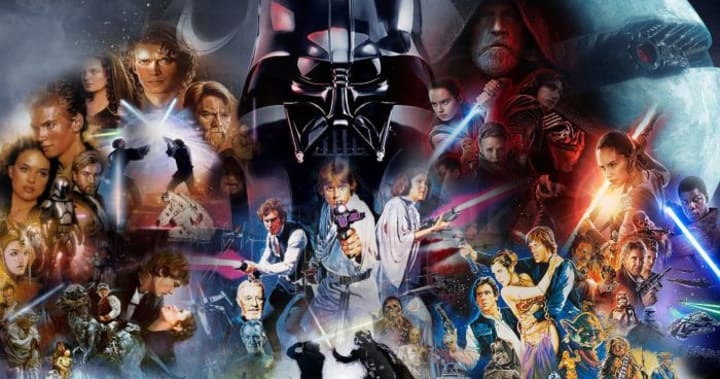Make Way For The 'Star Wars' Multiverse!
Anything Is Possible

Everybody loves a multiverse. Well, that is what pop culture would have you believe. Many of the franchises are now dabbling in multiverses one way or another.
Guess who is the straggler?
Star Wars.
The closest they have gotten to a multiverse is when they de-canonized all the existing Expanded Universe material after Disney bought Lucasfilm. However, the film properties themselves have remained pristine. Will they follow suit into some multiverse or other? If they do, what course will they take? Before tackling that question, it is worth examining just how multiverses have been employed in various franchises.
RELATED: Are We Expecting Too Much From 'Star Wars' On Disney+?
As far as cinematic pop culture goes, J. J. Abrams kicked off multiverses with his Star Trek reboot in 2009. A Romulan, Nero, traveled into the past, disrupting what was meant to happen (as far as we knew Star Trek), thus kicking off an alternate timeline. It is a pretty nifty innovation, so nifty that you have to imagine that either J. J. Abrams stumbled upon it by accident or a future J. J. came back to tell the present-day J. J. about it.

Effectively, Star Trek would reboot The Original Series, replete with all its beloved characters – characters who had built five decades of fans – with all new actors. We still have the William Shatner/Leonard Nimoy Star Trek universe, preserved forever in film and television, but now we got a Chris Pine/Zachary Quinto incarnation. This led to three movies, two new live-action television series, such as Star Trek: Discovery and Star Trek: Picard, and several other television properties.

Marvel is another franchise playing with the multiverse on several fronts. When they gained the temporary rights to arguably their hottest star, Spider-Man, fans bemoaned that they would have to endure another Spider-Man reboot just after the Marc Webb/Andrew Garfield reboot of the Sam Raimi/Tobey Maguire trilogy. Marvel detoured around the problem by giving Spidey a backdoor pilot, that is a pilot that uses an existing property to be its launching point, in Captain America: Civil War. Then came two movies: Homecoming and Far from Home. The latest movie, Spider-Man: No Way Home, incorporates Maguire’s Spider-Man and Garfield’s Spider-Man, as well as villains from their respective installments. Marvel has acknowledged that these alternate Spider-Mans are legitimate and that they exist in different universes/timelines.
Then you have Loki. While he was killed in Avengers: Infinity War, an earlier version of him was able to slip away in Avengers: End Game. The limited series, Loki, would use the multiverse as its playground, validating not only its existence but how it functions.

Superhero franchises have often played with the multiverse concept. Television’s The Flash was one of the early explorers. Initially, it was employed as a gimmick to find other Harrison Wells, The Flash’s mentor and antagonist in season one, as well as play with alter egos for the main cast. But then The Flash incorporated Supergirl, a character who had her own television series, as coming from a different Earth. Now, The Flash, Supergirl, and various other characters have a crossover storyline in an annual “Crisis on Infinite Earths,” a multi-part story with an installment in each respective series. They are wonderfully done. You wonder why these writers are not in charge of the DC movies.

The cinematic DC uses the multiverse primarily as an inter-dimensional Arkham Asylum where they can banish their ill-received and misbegotten properties (which makes Zack Snyder’s director’s cut of Justice League an ironic attempt at rehabilitating a hopeless cause). It is something that was not born out of design, but necessity, and then was exploited for opportunity.
Superman, Batman, and the Joker are all DC heavyweights who made underwhelming screen debuts in Man of Steel, Batman vs. Superman: Dawn of Justice, and Suicide Squad. Instead of getting a Man of Steel II (as originally intended), Supes was diverted into Batman vs. Superman: Dawn of Justice. Henry Cavill would make a brilliant Superman if he was allowed to get out of brood mode. Ben Affleck, who many initially were wary of as Batman, excelled in the role but could not do much with the material. Jared Leto’s Joker in Suicide Squad was an interesting portrayal, an attempt to divorce the character from Heath Ledger’s brilliant depiction in The Dark Knight and make it gangster, but which ultimately felt asynchronous.
Where to go from here as DC’s fast-tracked universe was already crumbling? Todd Phillips created his standalone Joker in Joker, featuring Joaquin Phoenix, which ignores Leto’s Suicide Squad portrayal. Matt Reeves’s The Batman, starring Robert Pattinson, ignores Ben Affleck’s Batman, while the batgrandaddy, Michael Keaton’s Batman, has made cameos in television’s The Flash, as well as the upcoming The Flash movie.

Star Wars has always been a straightforward narrative. There is no technobabble behind why hyperspace works, how shields function, or the damage that weapons inflict. Unlike its intellectual big brother, Star Trek, there are no parallel dimensions, time travel, or spatial anomalies. About as fancy as Star Wars gets is toying with the Force.
The sequel trilogy divided audiences. Rogue One was generally well-received, but as a standalone and self-contained movie, it did not carry the expectation that the others did. Solo had the unenviable job of providing a compelling backstory for one of the franchise’s most popular characters. It fizzled as spectacularly as the Millennium Falcon’s hyperdrive, leaving the rest of Disney’s Star Wars cinematic universe stalled and adrift.
The Mandalorian is an interesting foray into television: a character who is a blank slate, navigating a universe that is also a blank slate. Details are painted in gradually. It is as if creator Jon Favreau recognized the damage that had been done to the brand, erased the canvas, and started afresh, but tentatively. We did not get the bigger and bolder strokes until much later on when we would get murals.
The Book of Boba Fett has tried to forge a life for the iconic character Boba Fett. Many on social media have pilloried the series, believing it betrays just who Boba Fett is, although given he has about six minutes of screen time and four lines of dialogue in the original trilogy, there is not exactly a lot to work with, outside of stoicism, menace, and a helmet. The narrative dives right into things fans are familiar with like Tatooine, the Hutts, the Tusken Raiders, Jawas, and more.

Favreau’s television universe has distinguished itself from the cinematic universe, and he is building a fan base who will invest in his direction and vision, and possibly expect him to take, if not be promoted, to the cinematic reins. Disney will have to venture back into film with Star Wars at some point. They cannot hide on television forever.
When Disney launches back into cinema, what will happen to the sequel trilogy, Rogue One, and Solo? Will they survive and the new movies (and their stories) be built around their events? Or will they be de-canonized and the slate wiped clean? There has been online speculation, but that is all it is at this stage. Pop culture gurus on YouTube have been extrapolating (based on what, though, I don’t know) that the sequel trilogy will be erased, but these same experts have been telling us that Kathleen Kennedy has been on the way out for the last five years. One year, they will get it right and declare themselves prophets.
The more important question is what is Favreau’s strategy? There is no doubt that he has established himself as a power broker in the Star Wars universe. He has also shown with The Mandalorian that he is content with playing the long game. After all, his Luke Skywalker arc was two seasons in the making. In this time of heady storytelling where everything needs to happen just about immediately (unless you are watching Matrix: Resurrections, in which case it takes about two hours to get started) that is extraordinary planning, patience, and foresight.
So where are Favreau’s series going? Right now, they sit between the original trilogy and the sequel trilogy. Nothing that has happened in the two existing series (The Mandalorian and The Book of Boba Fett) has impacted the sequel trilogy in any way. However, there have been some practice swings that hint that a whack or two might be coming.
The sequel trilogy establishes that Ben Solo turned on Luke Skywalker and killed all the other Padawans, then re-christened himself Kylo Ren. (If he had become a Sith, he no doubt would have been anointed Darth Tantrum.) Certainly, we were not told if anybody escaped (although obviously this could be retconned if need be). Snoke and Kylo were not on the lookout for any other Jedi apprentices, as it seemed Luke was the lone resistance (well, until Rey came along).
On the other hand, The Mandalorian shows that Luke Skywalker has taken on Grogu as an apprentice. We do not know Grogu’s aging cycle – we do know it is slower than humans – but by the time of the sequel trilogy, he should at least be comparative to a teen. What happens to him? Does he die before the sequels take place? Does Kylo kill him? Did he quit being a Jedi? Does he replace Kathleen Kennedy at Lucasfilm?
The possibility does exist that Favreau may set up his own Star Wars universe, building characters, events, and circumstances, which rise like a tsunami and, before anybody realizes it is coming, and then obliterate the events of the sequel trilogy. If that is the case, then what would happen to the sequel trilogy? Will it be ignored, the way the Highlander franchise (that is four more movies and three series) ignored the gloriously abysmal Highlander II: The Quickening? Or do they shunt the sequel trilogy into some parallel universe where it can be compartmentalized and relegated to little more than an oddity, the way Star Wars: The Holiday Special is regarded?

“Difficult to see,” Yoda says. “Always in motion is the future.” For every choice, there is a fork. Each fork leads to an alternative future. Yoda and Obi-Wan Kenobi implore Luke not to charge off to Cloud City. Yoda himself cannot foresee Han’s and Leia’s fates. Who knows what might have happened had Luke remained on Dagobah? Perhaps Disney’s cinematic Star Wars universe is not a continuation of the Lucas timeline, but some schism.
Luke’s time on Ahch-To where he exiled himself to die (yet left a map, because he is a bit of an attention-seeker apparently) may be the timeline he sees if he decides to VANISH. The next Star Wars movie could have Luke divining the future on Dagobah, and the entire sequel trilogy relegated to a vision of some alternate timeline.
Given how mixed the reception to Disney’s cinematic Star Wars universe has been, the multiverse is something they could explore. Could it function as an interdimensional trash compactor, if you will, where they will dump the installments that have not worked as well as they’d hoped?
Anything is possible.
READ NEXT: Which Other Star Wars Characters Deserve Their Own Show?
Written By LeKoupa
Syndicated From Culture Slate






Comments
There are no comments for this story
Be the first to respond and start the conversation.